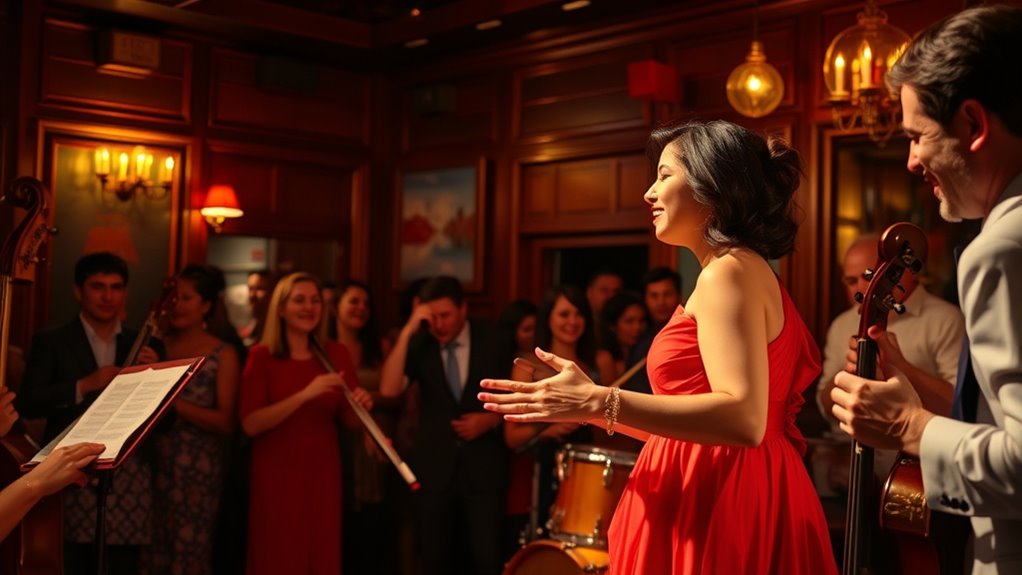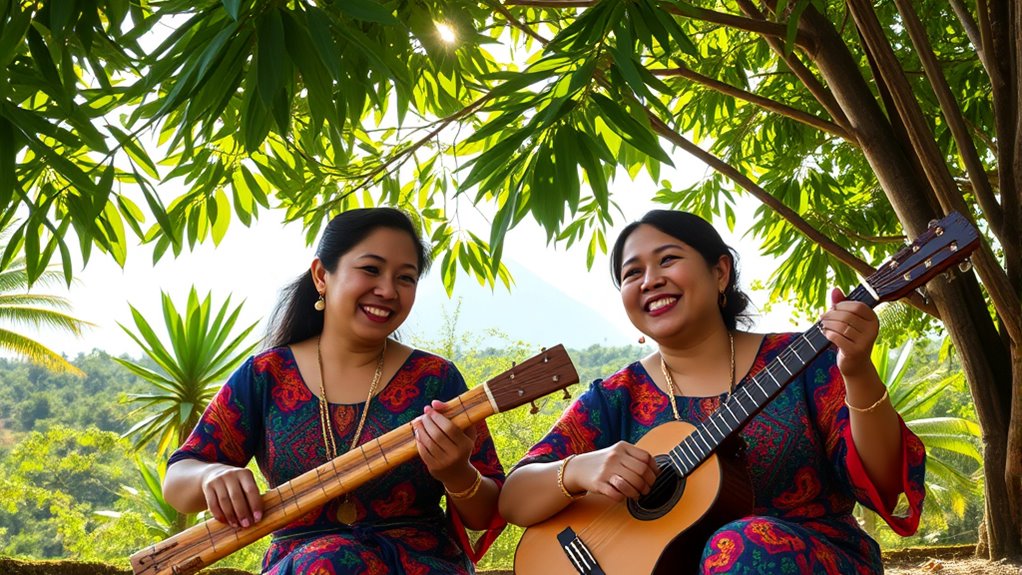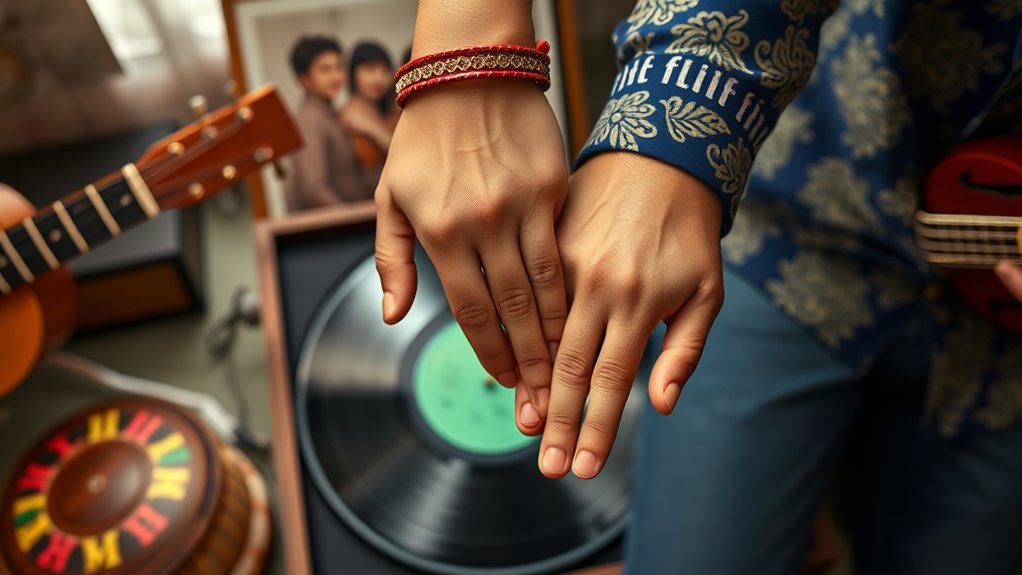Your Filipina love story thrives through music, beautifully blending influences from Spanish folk tunes and vibrant jazz. These genres create a backdrop for shared experiences and emotional connections. Indigenous sounds remind you of timeless cultural roots, while recent Pinoy music movements celebrate local pride and history. Media plays an essential role in keeping this rich heritage alive, offering platforms for collaboration and community. Discover more about how these elements shape your journey and connections.
Key Takeaways
- The influence of Spanish music in the Philippines has shaped romantic themes in songs, enhancing expressions of love and devotion.
- Kundiman, a traditional Filipino genre, embodies love and patriotism, often symbolizing deep emotional connections in relationships.
- Jazz, introduced in the 1920s, evolved love songs by blending traditional Filipino elements with innovative musical styles.
- Modern preservation efforts encourage collaborations between traditional and contemporary artists, fostering a vibrant musical landscape that celebrates love stories.
- Media platforms play a crucial role in sharing Filipino love songs, engaging communities, and preserving cultural identity through music.
The Influence of Spanish Music on Filipino Culture

Although Spanish colonization ended over a century ago, its musical influence on Filipino culture remains vibrant and pervasive. You can hear echoes of this legacy in folk music genres like *jota* and *zapateado*, which reveal Hispanic roots mingled with indigenous sounds. The importance of community and cooperation in these musical expressions reflects how music can unite diverse cultural backgrounds. The fusion of flavors from different regions mirrors the global culinary delights that inspire creativity in cooking. Additionally, the importance of protecting delicate skin is akin to how Filipinos cherish and preserve their rich cultural heritage. The integration of Alaskan historical influences enhances the understanding of how various cultures shape artistic expression over time.
The rondalla, a traditional string orchestra featuring instruments like the banduria, showcases this fusion beautifully. Regional variations, such as Cebu’s *sinulog*, highlight how distinct styles emerged from Spanish traditions.
Festivals and fiestas often bring these musical influences to life, celebrating the rich cultural tapestry of the Philippines. The integration of religious music and folk dances, alongside modern adaptations of Spanish instruments, guarantees that this heritage continues to thrive in contemporary Filipino music, enriching your cultural identity. Additionally, these celebrations often serve as community bonding opportunities, enhancing social connection among attendees.
The Rise of Jazz and Its Impact on Filipino Music

The vibrant tapestry of Filipino music continued to expand with the introduction of jazz in the 1920s, a genre that quickly took root amid the cultural shifts of the colonial period.
Jazz, initially viewed as a symbol of modernity, sparked a wave of innovation among Filipino musicians. They embraced this new sound, blending it with traditional elements to create unique styles.
Jazz emerged as a symbol of modernity, inspiring Filipino musicians to innovate and fuse traditional elements into unique styles.
As jazz gained popularity post-World War II, urban areas like Manila became cultural hubs. Jazz clubs became social spaces for artistic expression and cultural exchange.
Notable artists like Eddie Munji III and Bong Penera showcased this fusion, allowing Filipino musicians to gain international recognition.
Jazz not only reshaped local music but also contributed to a distinct post-colonial cultural identity.
Indigenous Sounds: The Roots of Filipino Musical Heritage

As you explore the roots of Filipino musical heritage, you’ll discover a rich tapestry woven from the diverse cultures of the country’s indigenous peoples.
Traditional music reflects this cultural diversity, often featuring instruments like the kulintang, a fascinating set of gongs. Geographical factors, such as rivers and mountains, shape various music styles and instruments, while cross-cultural exchanges enrich the landscape further.
Indigenous music plays an essential role in maintaining community identity, serving as a medium for storytelling, rituals, and emotional expression. Elements like drums and nose flutes symbolize cultural significance, emphasizing resilience against external influences.
With modern preservation efforts, today’s musicians blend traditional sounds with contemporary genres, ensuring that these unique musical roots continue to thrive in the modern world.
Evolution of Pinoy Music Movements Through the Decades

Throughout the decades, Pinoy music has undergone a dynamic evolution, shaped by cultural shifts and global influences.
Pinoy music has continuously evolved, reflecting cultural changes and global influences throughout the decades.
In the late 19th century, kundiman emerged, celebrating love and patriotism, while early 20th-century recordings like “Dalagang Bukid” marked the birth of original Filipino compositions.
As the post-war era arrived, Filipino artists began blending Western styles like jazz and rock, creating a unique sound that defined the 1950s and 60s.
The 1970s brought the Manila Sound, characterized by catchy melodies and disco influences, with festivals promoting original Filipino music.
The Role of Media in Preserving Filipino Music Heritage

Pinoy music’s rich history faces both challenges and opportunities in today’s digital age. Media plays an essential role in preserving this heritage by enhancing accessibility to various Filipino music genres for global audiences.
Digital platforms allow you to explore and enjoy traditional music while raising awareness about its cultural significance. Institutions like the National Research Council of the Philippines are important for studying and safeguarding these musical treasures.
Collaborations between traditional and modern artists invigorate cultural heritage, blending styles that resonate with younger generations. Despite challenges like copyright issues, media fosters community engagement and strengthens cultural identity, ensuring that the storytelling and generational knowledge embedded in Filipino music endure for years to come.
Frequently Asked Questions
How Do Personal Experiences Influence Love Songs in Filipino Music?
Personal experiences shape love songs in Filipino music by infusing them with authenticity and emotion.
When you listen, you might recognize the feelings of longing or heartache that resonate with your own life. These songs often draw from real-life stories, allowing you to connect deeply with the lyrics.
The blend of personal narratives and cultural themes creates a rich tapestry, making the music relatable and meaningful for you and others who share similar experiences.
What Role Do Lyrics Play in Expressing Love in Filipino Songs?
When you listen to Filipino love songs, you notice how lyrics beautifully express love’s complexities. They pull you in with metaphors and relatable narratives, making you feel those deep emotions.
You can’t help but connect with the heartfelt ballads that capture joy and heartbreak alike. As you immerse yourself in these songs, you realize they resonate across cultures, offering a poignant glimpse into love’s universal journey and your own experiences.
How Has Romantic Music Evolved in the Philippines Over Time?
Romantic music in the Philippines has evolved markedly over time. You’ll notice how traditional forms like Harana and Kundiman laid the foundation, expressing love through metaphor and emotion.
As the early 20th century progressed, Filipino artists blended various styles, introducing modern elements. By the 1970s, genres like Manila Sound emerged, incorporating upbeat rhythms.
Today, you hear catchy Pinoy Rock and Pop, showcasing simpler lyrics while still capturing deep feelings in contemporary ways.
Are There Specific Filipino Instruments Associated With Love Songs?
When it comes to Filipino love songs, instruments like the banduria and ukulele create enchanting melodies that resonate with romance.
The acoustic guitar’s warmth adds an intimate touch, while the violin often evokes deep emotion.
You’ll find that traditional instruments, alongside contemporary ones like keyboards and synthesizers, blend beautifully to enhance the heartfelt themes in love songs, making them deeply significant in Filipino culture and personal connections.
How Do Love Songs Reflect Filipino Cultural Values and Traditions?
Love songs reflect Filipino cultural values and traditions by emphasizing respect, family involvement, and community support.
When you listen to these songs, you’ll notice themes of longing and devotion, which highlight the emotional depth of relationships. They often incorporate traditional values like humility and patience, reinforcing the importance of family approval.
As you explore these melodies, you’ll connect with the rich heritage that binds generations together through shared experiences and heartfelt expressions.
Conclusion
As you wander through the vibrant streets of Filipino music, you’ll discover a garden where each note blooms like a flower, nurtured by the rich soil of history and culture. Just as a river carries stories from one shore to another, the melodies you’ve embraced weave connections that transcend time. So, let your heart dance to this symphony, for in every beat lies the spirit of a nation, inviting you to celebrate a love that grows ever stronger through the power of music.









